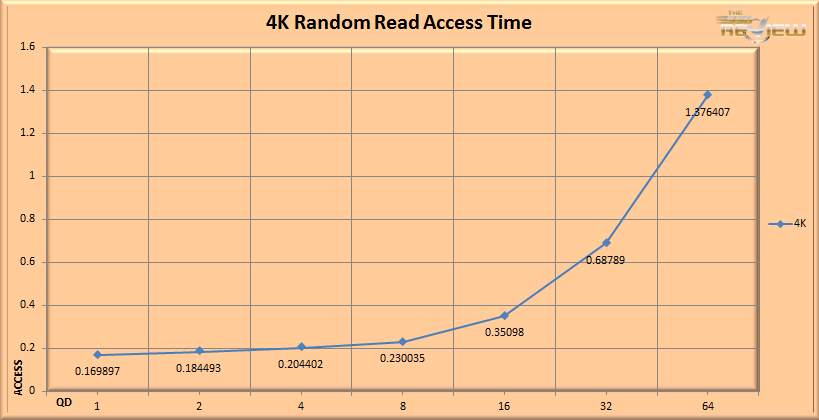FOB READ MEASUREMENTS
FOB (Fresh Out of Box) measurements are taken when the SSD is new and hasn’t been subjected to any use. As the device is used more we will see some lower results with write activity. Read speeds largely remain unchanged, so we can use these numbers as a comparison for the overall performance of the SSD.
The 4k Read Latency is a very important measurement, as it shows the overall responsiveness of the SSD under varying Queue Depths (QD). At the QD of 1, the 4k random access time comes in at .16, which is an expected value. As the QD raises the access times increase in line, but shoot up very quickly over QD32. In normal usage scenarios, the SSD would not be subjected to QD higher than 32.
 The 4k Random Read speed is very important, as it shows the performance of the SSD when using small files. Small file access is the hardest type of access for any storage device to master. The P400e maxes out at 46,5012 IOPS at a QD of 32.
The 4k Random Read speed is very important, as it shows the performance of the SSD when using small files. Small file access is the hardest type of access for any storage device to master. The P400e maxes out at 46,5012 IOPS at a QD of 32.
 The 128K sequential write speeds are very good, as the device does read very well with sequential data. This measurement also will not waver with varying levels of steady state. These are very good performance numbers, and the P400e maxes out around 455 MB/s at a QD of 64.
The 128K sequential write speeds are very good, as the device does read very well with sequential data. This measurement also will not waver with varying levels of steady state. These are very good performance numbers, and the P400e maxes out around 455 MB/s at a QD of 64.
The Random Write speed can be very telling for performance in real environments. Mixed Read/Write workloads can become very dependent upon the write speed that is sustainable over a period of time. We will also begin delving into the difference between FOB (Fresh Out of Box), Steady State, and 20% over provisioned execution. Enterprise SSDs list both FOB and Steady State performance, which is crucial considering the environments that they are deployed into.
FOB testing consists of an 8GB LBA. The Steady State testing is conducted at 100% fill capacity, and utilizes full span writes. This is truly the ‘torture test’ and gives an accurate picture of the SSD under the most demanding circumstances. 20% OP testing consists of 20% of the drive being left unformatted. The formatted region is filled to capacity, and written to full span.
4K again being a key metric, we conducted the testing at the 3 different drive states to get a full picture of the drive under various conditions. This is one of those times when we had to rerun the tests several times to confirm our results. The drives come in well over the published specifications with random write performance maxing out at 10,838 IOPS in Steady State. Considering that this drive is designed for read-centric environments, and the listed speed is only 7,500 IOPS, this was very encouraging. With 20% OP added the drive scales up to 12,418 IOPS @QD32. These are very good results, and indicative that Micron took a very conservative approach to their rated specifications.
 The SSD Review The Worlds Dedicated SSD Education and Review Resource |
The SSD Review The Worlds Dedicated SSD Education and Review Resource | 
$100 for a 50GB drive is not too shabby IMHO. There are a lot of applications which could use something another rung up the ladder from the Micron M400 at a decent price.
To be quite honest the price of this ssd is simply outstanding for its feature set. I feel that it is underpriced but dont tell Micron 🙂
https://goo.gl/urqzK
Had two fail. 2 out of 2